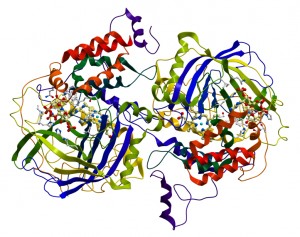- December 6, 2013
- Posted by: Life Cycle Associates
- Categories: Carbon Intensity, Cellulosic Ethanol, Fuel Standards, GHG Emissions
 Determining the contribution of enzymes to the carbon intensity of ethanol is challenging because the inputs for enzyme production often occur outside of the boundary of the cellulosic ethanol plant. To determine the GHG impact, the enzyme treat rate per tonne of feedstocks is combined with the ethanol yield and the life cycle inventory for enzyme production. The calculations must be performed with a consistent moisture basis for the feedstock and enzyme. In some instances, enzyme treat rate is reported on a solution basis, while in other instances the treat rate is reported per unit of protein.
Determining the contribution of enzymes to the carbon intensity of ethanol is challenging because the inputs for enzyme production often occur outside of the boundary of the cellulosic ethanol plant. To determine the GHG impact, the enzyme treat rate per tonne of feedstocks is combined with the ethanol yield and the life cycle inventory for enzyme production. The calculations must be performed with a consistent moisture basis for the feedstock and enzyme. In some instances, enzyme treat rate is reported on a solution basis, while in other instances the treat rate is reported per unit of protein.
The GHG intensity of cellulosic ethanol has been examined often. For example, fuel production processes with qualifying renewable feedstocks generate cellulosic RINs under the RFS2. However, cellulosic ethanol does not have a default carbon intensity value in California’s LCFS Look-up Table.
Therefore, to sell cellulosic ethanol in California, a Method 2B application must be submitted to the California Air Resources Board (ARB) including supporting calculations in CA_GREET. Unfortunately, CA_GREET does not include the yeast and enzyme emissions. To facilitate our clients’ Method 2B applications, Life Cycle Associates has built a CA_GREET sub-module to quantify emissions associated with production and transport of yeast and enzymes for cellulosic fuel production. The enzymatic sub-module implements the calculations from GREET_1 with the LCI data for inputs in the CA_GREET model. This approach allows for a consistent calculation of the contribution of enzymes for a cellulosic pathway using the same LCI data for process fuels as the rest of the CA_GREET model.
Of course, users still need to check for the moisture basis for feedstocks and enzymes.
